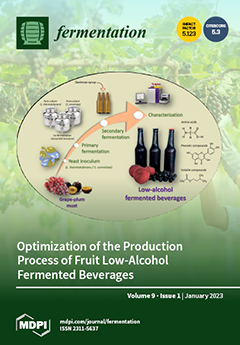Mahweu is an important indigenous beverage for many low-income and undernourished consumers in southern Africa. As a result, the nutritional and phytochemical profile of
mahewu samples (obtained using optimized fermentation and boiling conditions from a previous study) as well as their related raw materials (white and yellow maize) were investigated. At these conditions, white and yellow maize
mahewu (WM and YM) were prepared utilizing various inocula including sorghum malt, wheat, millet malt, or maize malt, and the pH, titratable acidity (TTA), total soluble solid (TSS), and proximate analysis were determined. The mineral content, amino acid composition, and phenolic compound profile were also investigated using inductive coupled plasma optical emission spectrometry (ICP-OES), high-performance liquid chromatography (HPLC), and ultra-high performance liquid chromatography-quadrupole time-of-flight mass spectrometry (UHPLC/Q-TOF-MS), respectively. Fermentation was observed to have influenced the proximate composition of obtained
mahewu samples compared to the raw flour with significant (
p ≤ 0.05) improvement in protein from 8.59 to 9.7% (YM) and 8.78 to 9% (WM) as well as carbohydrate from 72.27 to 74.47% (YM) and 71.15 to 72.65% (WM). Sodium, magnesium, phosphorous, potassium, calcium, manganese, iron, copper, and zinc were the minerals detected in the
mahewu samples, while potassium was the most abundant mineral, having values ranging from 3051.61 to 3283.38 mg/kg (YM) and 2882.11 to 3129.97 mg/kg (WM). Heavy metals detected in this study were all below the recommended tolerable levels by the Joint FAO/WHO Expert Committee on Food Additives (JECFA). Arginine and leucine with values ranging from 0.47 to 0.52 g/100 g (YM) and 0.48 to 0.53 g/100 g (WM) as well as 0.91 to 1.04 g/100 g (YM) and 0.95 to 1.01 g/100 g (WM), respectively, were the most abundant essential amino acids, whereas for non-essential amino acids, glutamic acid, aspartic acid, alanine, and proline were observed to be abundant. Based on the different inocula, the derived
mahewu samples prepared using either white or yellow maize have varying nutritional and health beneficial components and the choice of inocula might still be determined by consumer preference.
Full article





